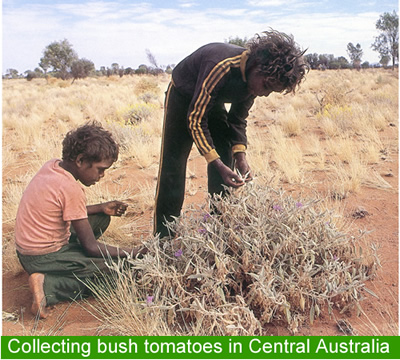
Summary of final report on the Australian Flora Foundation funded project:
Krystyna A Johnson and Amani K Ahmed1
University of Technology, Sydney, Department of Environmental Sciences, Westbourne St, St Leonards Campus, NSW, 2065
1Current address: Centre to Advance Learning in Economics and Business –Caleb, Faculty of Economics and Business, The University of Sydney, NSW, 2006
Solanum centrale JM Black (bush tomato) (Solanaceae) commonly called bush raisin or bush tomato, or known locally as kampurarpa, is a small clonally spreading undershrub with yellow fruit that dry on the plant to resemble a raisin. The fruit provides excellent nourishment and is recognised as possibly the most important of all Central Australian native plant foods, and is one of the key commercially significant ‘bushfood’ species. One of the main obstacles to the horticultural cultivation of S. centrale is the low germination rate of the seed. Seed viability and the effects of heat, smoke, soaking, leaching, temperature, scarification and NaCI salinity on germination rates and percentages were investigated. Seed dormancy is imposed by the seed coat; once scarified, germination of two seed lots approached the viability levels determined through tetrazolium testing. Germination did not differ at temperatures of 12, 20 or 28°C, indicating that there is no seasonal temperature preference. Soaking and leaching promoted germination in one each out of five experiments, while heat had no effect. Smoke enhanced the total germination of three of the six provenances tested, once dormancy was broken by seed coat scarification. The seeds showed considerable salinity tolerance, germinating in solutions of up to 200mM NaCI, although 0 and 25mM NaCI produced higher total germination
As part of this research, a plant tissue culture system was developed that stimulated multiple shoot initiation from different types of explants, resulting in multiple shoot clumps forming on various media within 6 weeks. Aseptic cultures were initiated from mature plants, using apical shoots of 5mm in length and placed on basic MS medium supplemented with 2µM BAP. Three types of explants were investigated: apical buds, nodal cuttings with one axillary bud per explant, and leaf segments of 10mm2 including the mid vein. The formation of adventitious shoots was achieved using half-strength MS medium with B5 vitamins and BAP, kinetin, and zeatin at concentrations of 1, 5, 10 and 25µM with IAA at 1µM. Roots formed when clumps of shootlets were transplanted to the glasshouse environment and planted in perlite:sand:peat potting mixture.
